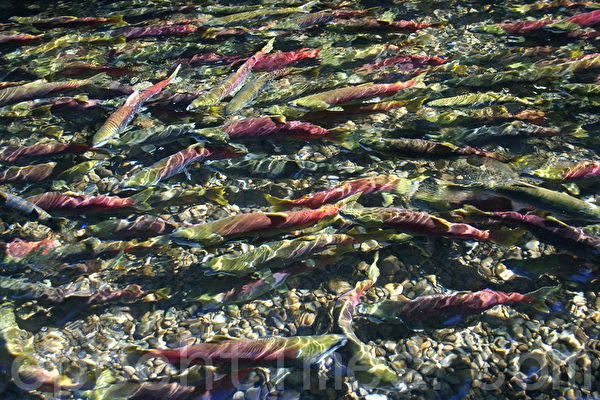In British Columbia, Canada, some salmon hatcheries are experiencing the best salmon run in a decade, much to the excitement of experts. However, the reasons behind this unexpected surge in salmon run cannot be definitively explained, as the experts consider the Pacific Ocean to be a “black box.”
Salmon, also known as Chinook salmon, usually hatch in freshwater, spend most of their adult lives in the ocean, and then swim upstream against the current to return to rivers, where they spawn on gravel beds. After spawning, these Pacific salmon, like most Atlantic salmon, will die. The life cycle of a salmon population restarts with the birth of a new generation of offspring.
The salmon run in British Columbia is one of the most spectacular migrations in the world. Every October, tens of thousands of Chinook salmon heed the call of nature to complete their biennial spawning mission.
According to a report on todayinbc.com on December 4th, Greg Taylor, a senior fisheries consultant at the Watershed Watch Salmon Society in British Columbia, stated: “Compared to the past 15 years, the return of salmon this year… I believe is definitely at or above average levels.”
“We are seeing good returns for various salmon species and populations,” Taylor said. “On the east coast of Vancouver Island, we are seeing very good returns of Chinook salmon and Coho salmon.”
“On the west coast, we are seeing extremely good returns of Sockeye salmon,” he continued.
Taylor highlighted another encouraging sign, the reappearance of Rainbow Trout, a member of the salmon family, that were previously believed to be facing extinction in many watersheds.
Peter McCully, a biologist at the Goldstream hatchery in the Greater Victoria area and a long-time volunteer, also expressed excitement about the higher-than-expected number of salmon returning this year.
Initially hoping to reach a threshold of 15,000 returning Chum salmon, McCully reported that over 20,000 Chum salmon have returned to the rivers this year. Additionally, the hatchery harvested up to 1,800 Coho salmon, which McCully described as a “very significant” number.
Chum salmon, also known as dog salmon, is the largest species of Pacific salmon, with individuals weighing up to 50 kilograms.
“I believe this is one of the best runs in the past 20 years,” he said. “It’s not a record-breaking return, but better than we expected.”
When asked about the reasons for the increase in spawning numbers across the province this year, experts remain puzzled by the growth.
“We still don’t quite understand what the reasons for the changes are, but the environmental conditions are very good and suitable for salmon,” Taylor said. “We have seen some significant changes in the Salish Sea; a large number of Chinook and Coho salmon are migrating.”
“For salmon, there is no definitive answer,” Taylor said. “From my observations… we see positive responses along the entire coast. We also see changes in the Northeast Pacific, where temperatures are more favorable for our salmon.”
As Taylor reiterates, the exact reasons behind the unexpected surge in salmon returns this year remain unclear, as some events in the ocean are still a mystery.
“This could be simply due to lower temperatures in the Bering Sea, or perhaps because of fewer predators. We don’t understand the reasons,” Taylor said. “In the fisheries industry, we call the Pacific Ocean a ‘black box’ because we are not entirely sure what is happening there.”

